Teledentistry, a subset of telehealth, is revolutionizing the field of dentistry by leveraging technology to bridge gaps in access to oral healthcare. Through virtual consultations, patients can connect with dental professionals remotely, overcoming geographical barriers, enhancing convenience, and improving oral health.

Teledentistry: Bridging Gaps in Access to Oral Healthcare
Let’s explore the key points highlighting the significance of teledentistry in addressing access to care issues:
1. Accessible Care Anytime, Anywhere
Teledentistry eliminates geographical barriers, enabling patients to connect with dental professionals regardless of location. Remote and underserved communities, where access to dental clinics is limited, can now receive expert advice, diagnoses, and treatment recommendations through virtual consultations.
2. Convenience and Time Efficiency
Virtual consultations save both patients and dentists valuable time. Patients no longer need to travel to a physical clinic, and dentists can efficiently manage their schedules by conducting virtual visits between in-person appointments.
3. Early Intervention and Preventive Care
Teledentistry facilitates early intervention by allowing patients to seek advice at the first signs of dental issues. Dental professionals can provide timely guidance on oral hygiene practices and preventive measures, potentially averting more serious problems.
4. Reduced Costs
Teledentistry can lead to cost savings for both patients and dental practices. Patients save on transportation and related expenses, while dentists can optimize their resources by addressing minor concerns remotely, reducing the need for unnecessary in-person visits.
5. Improved Oral Health Awareness
Through virtual consultations, dentists can educate patients about teeth health, proper brushing techniques, and dietary choices that promote dental well-being. This increased awareness empowers patients to take better care of their oral health.
6. Follow-up and Post-Procedure Monitoring
Teledentistry allows dentists to monitor patients’ progress after procedures remotely. This feature is particularly valuable for cases involving orthodontic treatments, oral surgeries, and implants, ensuring that recovery is on track.
7. Telediagnosis and Treatment Planning
Dental professionals can examine images and videos provided by patients and make accurate diagnoses and treatment recommendations remotely. This capability is particularly useful for initial assessments and follow-ups.
8. Dental Anxiety Management
For patients with dental anxiety, virtual consultations can provide a less intimidating environment for discussions. Patients start to feel more comfortable discussing their concerns through a screen, improving communication between patient and dentist.
9. Integration with Electronic Health Records (EHRs)
It can seamlessly integrate with electronic health records, allowing dentists to maintain comprehensive patient histories and treatment plans. This integration contributes to the continuity of care and ensures accurate documentation.
10. Ethical and Legal Considerations
The teledentistry practice raises ethical and legal considerations, including issues related to patient privacy, data security, licensure requirements, and the limitations of remote assessments. These aspects must be carefully addressed to ensure the quality and safety of virtual dental care.
11. Elderly and Immobilized Patient Care
Elderly individuals or those with limited mobility often face challenges in accessing dental care. Teledentistry provides a lifeline for these patients, enabling them to consult with dentists without the physical strain of travel. It is particularly important as oral health is closely linked to overall well-being, especially in the aging population.
12. Future Possibilities
As technology advances, the potential of teledentistry continues to expand. Integration of artificial intelligence, remote diagnostics through imaging, and even 3D printing of dental appliances could become feasible through virtual platforms, further enhancing the scope and effectiveness of teledentistry.
Conclusion
Teledentistry is a game-changer in the realm of oral healthcare. By harnessing the power of virtual consultations and cutting-edge communication technologies, it is dismantling barriers to access and improving the overall patient experience. As the field evolves, stakeholders must collaborate to address challenges, refine practices, and ensure that teledentistry remains a valuable tool for delivering high-quality dental care to individuals worldwide.



